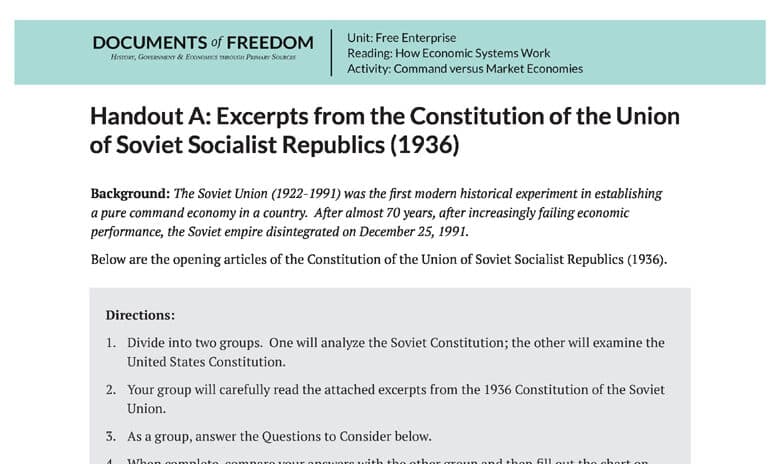Handout A: Excerpts from the Constitution of the Union of Soviet Socialist Republics (1936)
Handout A: Excerpts from the Constitution of the Union of Soviet Socialist Republics (1936)
Background: The Soviet Union (1922-1991) was the first modern historical experiment in establishing a pure command economy in a country. After almost 70 years, after increasingly failing economic performance, the Soviet empire disintegrated on December 25, 1991.
Below are the opening articles of the Constitution of the Union of Soviet Socialist Republics (1936).
Directions:
- Divide into two groups. One will analyze the Soviet Constitution; the other will examine the United States Constitution.
- Your group will carefully read the attached excerpts from the 1936 Constitution of the Soviet Union.
- As a group, answer the Questions to Consider below.
- When complete, compare your answers with the other group and then fill out the chart on Handout D together.
- Finally, answer the concluding questions on a separate sheet of paper. Answer each question in well-written, well-organized paragraphs.
- Be prepared to share your group’s answers with the class.
Questions to Consider:
When reading these constitutional articles, consider the following:
- What is the significance of the fact that the Soviet Constitution begins with articles directly related to the economy?
- In what ways was the state to be involved in the economy?
- What was the role of private property in the Soviet state?
- What elements of a command economy are included in the Soviet Constitution?
- What elements of a market economy are evident in the Soviet Constitution, if any?
Excerpts from the Constitution of the Union of Soviet Socialist Republics (1936)
ARTICLE 1. The Union of Soviet Socialist Republics is a socialist state of workers and peasants.1
ARTICLE 4. The socialist system of economy and the socialist ownership of the means and instruments of production firmly established as a result of the abolition of the capitalist system of economy, the abrogation of private ownership of the means and instruments of production and the abolition of the exploitation of man by man, constitute’ the economic foundation of the U.S.S.R.2
ARTICLE 5. Socialist property in the U.S.S.R. exists either in the form of state property (the possession of the whole people), or in the form of cooperative and collective-farm property (property of a collective farm or property of a cooperative association).3
ARTICLE 6. The land, its natural deposits, waters, forests, mills, factories, mines, rail, water and air transport, banks, post, telegraph and telephones, large state-organized agricultural enterprises…as well as municipal enterprises and the bulk of the dwelling houses in the cities and industrial localities, are state property, that is, belong to the whole people.4
ARTICLE 7. Public enterprises in collective farms and cooperative organizations, with their livestock and implements, the products of the collective farms and cooperative organizations, as well as their common buildings, constitute the common socialist property of the collective farms and cooperative organizations. In addition to its basic income from the public collective-farm enterprise, every household in a collective farm has for its personal use a small plot of land attached to the dwelling and, as its personal property, a subsidiary establishment on the plot, a dwelling house, livestock, poultry and minor agricultural implements in accordance with the statutes of the agricultural artel.5
ARTICLE 9. Alongside the socialist system of economy, which is the predominant form of economy in the U.S.S.R., the law permits the small private economy of individual peasants and handicraftsman based on their personal labor and precluding the exploitation of the labor of others.6
ARTICLE 10. The right of citizens to personal ownership of their incomes from work and of their savings, of their dwelling houses and subsidiary household economy, their household furniture and utensils and articles of personal use and convenience, as well as the right of inheritance of personal property of citizens, is protected by law.7
ARTICLE 11. The economic life of the U.S.S.R. is determined and directed by the state national economic plan with the aim of increasing the public wealth, of steadily improving the material conditions of the working people and raising their cultural level, of consolidating the independence of the U.S.S.R. and strengthening its defensive capacity.8
ARTICLE 12. In the U.S.S.R. work is a duty and a matter of honor for every able-bodied citizen, in accordance with the principle: “He who does not work, neither shall he eat.” The principle applied in the U.S.S.R. is that of socialism: “From each according to his ability, to each according to his work.”9
Source: http://www.departments.bucknell.edu/russian/const/36cons01.html
Annotations:
1Note that there is no role for professionals or entrepreneurs.
2Capitalism is abolished. Private ownership of the means of production (capital) is ended.
3Property belongs to the state or to cooperatives/collectives.
4Almost all property belongs to the state, rather than individuals.
5In a collective or cooperative, nearly all property belongs to the collective. Workers may have a small piece of land to work for themselves.
6Peasants and workers may have a “small private economy” provided it is based on their own handiwork.
7What workers earn is their property. They may also own some minor personal articles. This is protected by law.
8The state controls economic activity through its central economic plan. The purpose of the economy is improving the material conditions of working and in strengthening the state.
